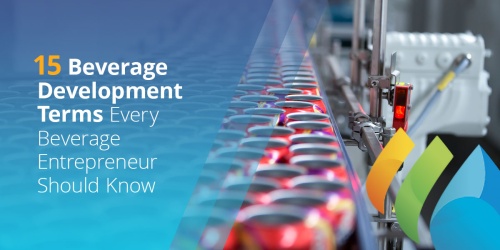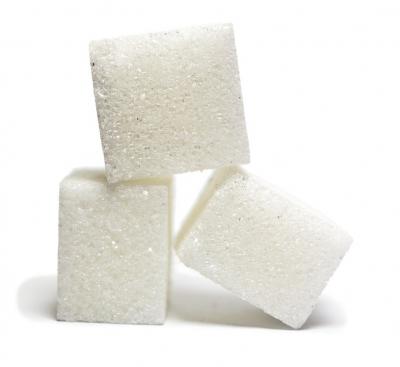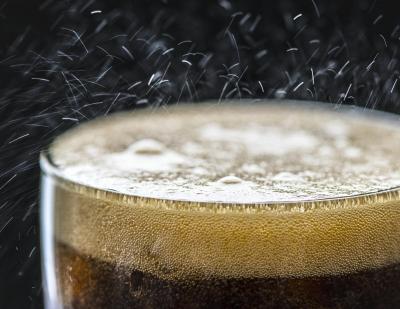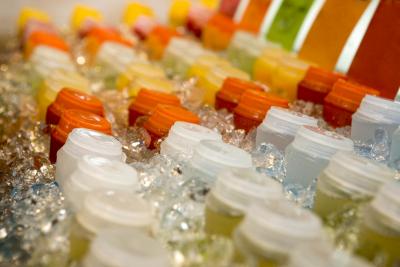15 Beverage Development Terms Every Beverage Entrepreneur Should Know

The world of beverage development is fascinating and fast-paced. It can also be complex and confusing. Mastering the art and a science that results in a successful beverage starts with both curiosity and hard work. Here is a brief overview of some of the terms that you may run across on your beverage development journey.
ABV/ABW
Alcohol by volume (ABV) measures the alcohol content of distilled spirits, wine, beer, and other alcoholic beverages. It tells you what portion of the total volume of liquid is alcohol. In some cases, alcohol by weight (ABW) is listed in place of ABV. You can multiply ABW by 1.25 to convert to ABV.
Batch Sheet
A document that lays out the procedure for making a batch of a beverage. The manufacturer starts with the beverage formula and scales it for mass production using the batch sheet. There is no set format for a batch sheet, but it contains specific instructions for adding, mixing, and processing the ingredients of a beverage to fit a certain tank volume. A batch sheet helps ensure that a consistent product is created each time it is produced.
Brix
A unit of measurement for dissolved conten t in a liquid solution. It was originally created by measuring the percentage (by weight) of sucrose (sugar) in a sucrose and water solution. One-degree Brix is equal to one gram of sucrose in 100 grams of solution. When producing a fermented beverage, Brix measurements help ensure that the proper range of sugar content is maintained when batching the beverage so that the final product meets the specifications provided in the beverage formula.
t in a liquid solution. It was originally created by measuring the percentage (by weight) of sucrose (sugar) in a sucrose and water solution. One-degree Brix is equal to one gram of sucrose in 100 grams of solution. When producing a fermented beverage, Brix measurements help ensure that the proper range of sugar content is maintained when batching the beverage so that the final product meets the specifications provided in the beverage formula.
Commercial Formula
Often, a beverage will start with a kitchen recipe that specifies ingredients for only five or ten gallons using commonly found ingredients. The commercial formula (commercial formulation) scales the ingredients and process to create up to 1,000 gallons of the beverage. A commercial formula is developed by a formulation specialist or food chemist using commercially viable ingredients and techniques to make the formula scalable. In turn, this allows the manufacturer to create a more effective batch sheet.
How To Create a Beverage Formula
When creating a beverage formula, several crucial steps are involved to ensure its successful development and production:
- Develop a comprehensive product specification sheet.
- Source appropriate ingredients and prepare accurate nutrition facts.
- Complete all necessary paperwork required by regulatory bodies such as the FDA and TTB (if required).
- Conduct rigorous stability testing to assess the product's shelf-life and quality.
- Scale up the recipe from small measurements to larger quantities, ensuring consistency.
- Convert your recipe to a commercial, production-ready formula that can be used by a contract manufacturer.
- Streamline production processes and prepare detailed batching instructions for manufacturing.
- Create an appealing packaging design and develop clear labeling for the finished product.
Commercially Viable Ingredients
When turning a recipe into a formula for mass production, you need to consider the ability to source the ingredients in the amounts and within the cost and timeframe constraints that you will need them. Scaling your recipe using commercially viable ingredients ensures that your end product can be successfully reproduced and brought to market.
CO2
Carbon dioxide (CO2) is a colorless, odorless, non-combustible gas typically used to carbonate soft drinks and  soda water. The high-pressure addition of CO2 to water when the drink is made and packaged creates the bubbles in these carbonated drinks.
soda water. The high-pressure addition of CO2 to water when the drink is made and packaged creates the bubbles in these carbonated drinks.
Opening the container of a carbonated beverage releases pressure and allows the carbon dioxide to bubble up through the liquid. Beverages can be carbonated at different levels, measured in volumes of CO2 per liquid volume. Levels can reach up to 5.0 volumes, but most beverages range from 1.5 to 3.9 volumes.
FIDS
Flavor manufacturers use the Flavor Ingredient Data Sheet (FIDS) to disclose information on certain ingredients that have usage rate limitations and could affect the labeling of an alcoholic beverage with the Alcohol and Tobacco Tax and Trade Bureau (TTB). A FIDS is required when your commercial formula uses a flavor consisting of multiple ingredients and must be provided with your formula when submitting an alcoholic beverage for approval by the TTB.
Flavor House
An organization housing food scientist and flavor chemists that specialize in creating flavors and formulation.
GRAS
“GRAS” means “Generally Recognized as Safe.” The U.S. Food and Drug Administration (FDA) uses this language to label certain ingredients or additives as safe for their intended use by experts. GRAS ingredients/additives are exempt from the Food, Drug, and Cosmetic Act (FFDCA) which requires all non-GRAS ingredients to be approved by the FDA, which can be a long, time-consuming process.
Organoleptic Testing
This type of beverage testing involves the use  of the human senses of taste, touch, sight, and smell to provide information about the acceptability of a beverage or an ingredient. Clues gathered by the senses, like an unusual smell, or inconsistent texture, can reveal issues with a product even before any other testing is conducted. Organoleptic Testing can be commonly referred to as a Sensory Analysis.
of the human senses of taste, touch, sight, and smell to provide information about the acceptability of a beverage or an ingredient. Clues gathered by the senses, like an unusual smell, or inconsistent texture, can reveal issues with a product even before any other testing is conducted. Organoleptic Testing can be commonly referred to as a Sensory Analysis.
Process Authority
Certain beverages, depending on the type and how they are produced, will require the expertise of a process authority. A process authority is a person or entity that has been expertly trained in food-handling techniques, food-protection principles and several other critical areas. The process authority helps to determine processing methods, measures, and analysis that ensure product safety and shelf-stability. A scheduled process is your commercial formulation and procedure, which has been review and edited by a recognized process authority and which must be followed exactly by the contract packer.
Preservation Methods
Physical and chemical methods used to extend the shelf life of beverages. Examples of preservation methods include thermal pasteurization, non-thermal pasteurization, and the use of potassium sorbate and sodium benzoate.
RTD
Ready-To-Drink (RTD) beverages are sold in a prepared form, ready for consumption. Ready-To-Drink options span categories including bottled or canned tea, coffee, energy drinks, smoothies, and cocktails, and are often sought after for the convenience they offer.
prepared form, ready for consumption. Ready-To-Drink options span categories including bottled or canned tea, coffee, energy drinks, smoothies, and cocktails, and are often sought after for the convenience they offer.
Shelf-Stable
A product that is considered shelf-stable has been processed in a way that allows it to be stored on a shelf in a sealed container. Some beverages that would normally need to be refrigerated can be preserved and packaged with techniques, or preservation methods, that create and extend shelf life. Making sure beverages stay stable through their required shelf lives is critical to their success in the marketplace. Shelf life is commonly estimated using either real-time stability tests or accelerated stability tests.
SKU
Each beverage has its own stockkeeping unit (SKU) assigned by the company that produces it. SKUs are used to track products in physical and online retail outlets, warehouses, and product fulfillment centers. SKUs also help shoppers compare characteristics of varying beverages in the same category. Online retailers often use SKU information to suggest related products during the online shopping experience.
TA
The abbreviation used for TA (titratable acidity). TA is an approximate measure of the total acid in your finished beverage. It is usually expressed in units of grams per liter (g/L). Although they are often used interchangeably, titratable acidity and total acidity are not the same thing. Total acidity is a more accurate representation of acid concentration but is also more difficult to measure. Co-packers use titratable acidity measurements to meet the ranges provided within a beverage’s formula.
Immersing yourself in terms and industry insights from the beverage development world is an excellent way to ensure your beverage is a success. It’s also important to remember that you’re not alone. BevSource specializes in helping beverage entrepreneurs develop, produce, and deliver their beverage ideas to the world. Give us a call!
Looking to learn more?
Beverage Development and Formulation
After building your drink formulation vocabulary, it's time to begin developing and launching your beverage. While beverage development may seem straightforward, the process contains many variables that can alter the outcome of your product. Luckily, the team at BevSource will be by your side at every step to help make your beverage dream a reality.
Learning how to create a beverage formula can seem daunting during the initial stages, especially if this is your first venture into the world of beverage creation. With the following beverage formulation steps, you'll have a blueprint for a greater chance of success.
1. Research the Beverage Creation Process
Knowing what to expect regarding beverage development and formulation costs before getting started can aid in creating a budget and timeline to meet your specific beverage needs to improve your bottom line.
Researching before starting the process can also help determine if you are ready to handle the commitment and cost needed to create a beverage. By performing as much research as possible, you can understand a realistic budget and how much to account for in unexpected expenses.
2. Learn Your Market
It's best to start the beverage formulation and development process by creating a marketing and sales plan before manufacturing or producing your product. As soon as your beverage comes off the assembly line, the pressure will increase to get it onto shelves and attract consumers, making it essential to ensure your product moves as quickly as possible.
Some questions to ask yourself as you determine your end goal include:
- What kind of product am I making?
- How is my beverage different from the competition?
- How much value does my drink offer?
- Do I have enough money to launch my beverage?
3. Understand the Costs Associated With Your Beverage Product
It's vital to remember that development is only one aspect of beverage creation. You must also consider what it may cost to package and sell your drink to consumers. As you create your budget, you'll want to consider categories such as:
- Ingredients
- Packaging materials
- Manufacturing
Each cost category can impact your direct costs, affecting your overall profit. Some examples to help you determine production expenses include:
Beverage Ingredients
Understanding your cost of goods sold (COGS) is vital to creating a profitable and sustainable beverage business. COGS refers to any direct costs associated with producing goods, including labor. In the beverage industry, your COGS will include ingredient and packaging fees and associated manufacturing, freight and warehousing expenses.
At BevSource, we have many industry connections with ingredient suppliers and distributors to help you bring your recipe to life.
Packaging
Packaging costs are a critical cost input and can vary widely depending on how you want to present your beverage on the shelf and how much you can afford. At BevSource, we can identify packaging that meets your budget and is compatible with your drink.
Manufacturing
When working with a co-packer, your COGS will be the price per unit you pay for your product. If you produce small quantities of your products, the cost per unit will likely be more expensive than larger amounts. While you may be able to get a better price per unit if you produce larger quantities, you run the risk of your inventory becoming obsolete.
It's vital to keep in mind that your beverage has a shelf life. If you manufacture more products than you can sell before your drink's shelf life runs out, you will experience a loss. Location is also an essential factor. You'll want to manufacture your beverage close to where you sell to keep your freight costs down.
At BevSource, we can help identify reputable and capable manufacturing partners that can effectively make your specific drink.
4. Develop a Winning Recipe
After developing a clear business plan, it's time to bring in a partner like BevSource. We'll connect you with formulation experts and project managers who will consult with you on your vision. The team will offer insights into relative costs, ingredient availability, manufacturing considerations and more before the project progresses into the recipe development stage.
The development stage involves formulation, developing prototypes and optimizing recipes. We'll create samples and send them to you to try and to provide feedback.
Once we perfect your drink formulation, our team will provide you with a commercial formula that you can provide to a manufacturing partner. Additionally, we can aid with the pilot production of your drink for focus groups or investors before sending the final product to a production partner.
Turn Your Beverage Idea Into a Reality With BevSource
At BevSource, we're passionate about formulating and developing beverages. Throughout our years in business, we've created almost every kind of drink available and we're confident we can help you bring your dream beverage to life.
We're passionate about helping clients and look forward to providing the guidance you need to turn your beverage idea into a profitable business venture. We invite you to complete our contact form to learn more about our beverage development and formulation process!
